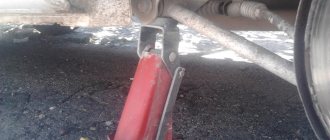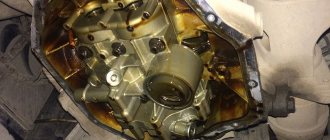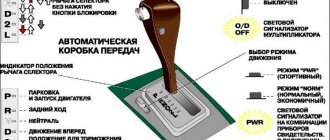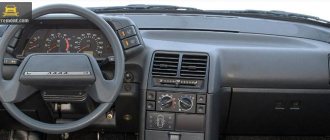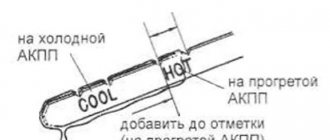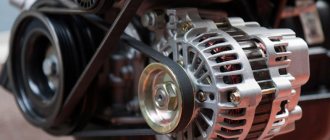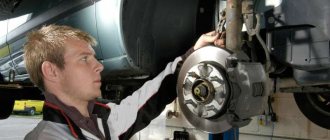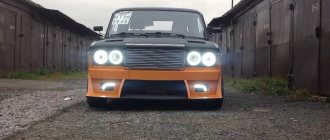01/25/2022 9,699 Transmission
Author: Victor
Continuously variable transmissions provide smooth gear shifting and do not have fixed first, second or fifth gears. Drivers became familiar with the principles of driving cars with CVT relatively recently. Therefore, you should learn how to drive a CVT correctly and what mistakes should not be made when operating the gearbox.
[Hide]
Overheat
There are two devices in the CVT box that generate a lot of heat. It can cause the entire gearbox to fail. So let's look at these two devices, why and under what conditions they generate increased heat.
Torque converter or clutch pack
Yes, in some CVT models there is a “donut” installed between the gearbox and the engine. It serves as a clutch. The torque converter is the first to take over the engine torque when starting off or driving at low speeds.
In continuously variable automatic transmissions, the torque converter is almost always locked . The exception is when the car is moving at low speed or standing still. At this moment the “donut” is unlocked, it begins to slip, generating a lot of heat.
Some CVT models use a clutch pack instead of a torque converter. This is also a clutch, the operating principle is different from the “donut”, but the ability to generate heat when slipping is the same. Plus, they wear out faster and emit friction dust during wear .
Box
During operation, the box itself generates heat. It is already known from the design of the variator that instead of toothed gears, a belt is responsible for shifting gears. Friction occurs between the belt and pulleys.
The smaller the diameter of any of the pulleys, the smaller the area of contact with the belt. Grip decreases and friction increases. This leads to the release of heat.
In order not to kill the variator, you need to carefully monitor the cooling system of the box. Check radiators for cleanliness and clean them if necessary.
Starting the engine
In position P
The engine can be started without pressing the brake pedal. In position N, the engine can only be started when the brake pedal is pressed. Turn on the ignition and start the engine.
Press the brake pedal and, pressing the lock button, move the gear shift lever from position P
to position
R
or
D
(depending on the desired direction to start moving). In this case, your foot should be on the brake pedal and the accelerator pedal should be released.
Huge pressure
You know that it is not recommended to tow trailers or other cars in a car with an automatic transmission. Driving through deep mud, accompanied by wheel slipping, will have a bad effect on the condition of the gearbox.
The same applies to the CVT gearbox. Only the consequences of such exploitation will be even sadder. The fact is that the variator does not have gears that are rigidly engaged with each other. Torque is transmitted through a belt mechanism.
The higher the gear ratio, the smaller the diameter of the drive pulley, the smaller the contact area of the belt with this pulley. The risk of the belt slipping along the pulley increases, which is fatal for the variator. Scores may appear on the cone plates, the belt may become damaged or break. And this is already an expensive repair of the box.
To protect the variator from rapid breakdown, you need to operate it in “gentle” conditions:
- Do not overuse towing trailers and downstream neighbors.
- When driving uphill with a load behind you, do not press the gas pedal to the floor. Smoothly pressing the pedal halfway, or better yet less, will protect the variator from slipping the belt. This applies to towing a trailer. If it’s not there, you can press down on the pedal and nothing will happen.
The main thing is that if you need to tow someone, pull a trailer, or overcome a small ford, do not press the pedal to the floor. The variator does not like heavy loads at low speeds.
Second place - oil change
And here it may seem that all recommendations for proper maintenance are similar to automatic transmissions. I don’t argue, there is some compatibility, BUT there are also differences.
I’ll start with the thesis that the oil (in general, this is a special liquid, often different from ATF ) needs to be changed - MANDATORY! On old NISSANS, the replacement interval was generally 30,000 km, then CVTs were improved (or supposedly improved), and now they need to be changed after 60,000 km. Now they can install various oil aging sensors , you can rely on their readings. However, again there are companies that say that replacement is not required and it is designed to last a lifetime, this is not correct.
Here, as in an automatic transmission, you need to change the fluid + filter (if possible). If it is not possible to change the filter, then make the internal lubricant change intervals shorter, for example after 50,000 km (and not after 60 thousand). This way the lubricant oil will not become too contaminated and you will remove it while still light and refill it fresh.
So why is it so important to change the oil inside? YES everything is simple, there is also a valve body and solenoids, only they work differently. Often, the pressure in the system, which brings the cone together, depends on their quality of work.
If the oil is dirty (wear occurs in any case), dirt particles can clog the valve body or these solenoids. As a result, there is insufficient pressure, the cones are not brought together correctly (there is no required pressure), the belt slips - scuffing.
Pedal to the floor
This is the weakest aspect of the continuously variable transmission. The more often you drive “sneaker to floor”, the faster the variator will fall apart. With a quiet ride, in the “pensioner” style, it can last many hundreds of thousands of kilometers.
The main thing for yourself is to learn one rule: “If you feel that the car is hard right now, do not press the pedal all the way” - this will greatly extend the life of the variator.
Automakers are aware of the problem and are trying to combat it. Some models have additional gears for low gears.
In some cases, where there is no such “planetary”, when driving onto a curb from a standstill, the computer “strangles” the engine, preventing it from developing maximum torque. In this case, you will not be able to drive onto the curb if you drive up close to it and stop. No matter how you turn the engine, the electronics will not allow the car to move in order to protect the variator from damage.
When to engage neutral gear on a manual transmission?
When you stop while climbing a slope and put the car on the hand parking brake, shift to neutral gear. Next, you need to depress the clutch pedal and engage first gear.
Interesting materials:
How to store garlic in oil? How to store garlic in sand? How to store garlic in vegetable oil? How to store garlic in salt? How to store garlic in the ground? How to store garlic in winter? How to store Chubuki until spring? How to store a cast iron frying pan? How to store baby gladioli until spring? How to store baby gladioli for the winter?
Jerks
A similar effect can be observed when you slip a wheel and suddenly it hits a hard surface. That is, rotating at high speed on ice, for example, it stops abruptly when it reaches the asphalt. There is a shock in the transmission. Or when towing another vehicle. You take off, the cable tightens, and you suddenly stop. The blow comes again.
In both cases, the belt may slip along the pulley. One such slip will be enough to scratch the pulley. After this, increased wear and rapid “death” of the gearbox occurs.
Unlike climbing a curb, the electronics do not protect the CVT in such situations. It simply does not have time to “strangle” the engine in order to reduce the torque on the pulley and protect the variator.
If there is an urgent need to pull someone out with a cable or drive yourself out of a snow mess, there are small tricks that will help save your continuously variable transmission.
When towing with a cable:
- Smoothly select the length of the cable so that it becomes taut.
- When it reaches its maximum length, release the gas pedal. The inertia of your car will be enough to pull someone out of the mud or carefully take off from a standstill without damaging the CVT.
If your wheels slip on ice:
No need to press the gas pedal to the floor. To make the wheels spin on ice and the car to get out of the slippery surface, just press the gas halfway. When the wheel reaches the asphalt, the box will not feel a strong impact.
Operating the variator (brief instructions)
Latin letters, instead of numbers on the manual transmission shift knob, mean the following:
- "P"
- parking mode. Parking for a long time causes the control system to become blocked. When igniting, make sure that the lever is set at the same mark; - "D"
- the car is in motion. The car moves forward with a characteristic smooth change of steps; - “N” is
an analogue of “neutral”. In the continuously variable version, the gearbox is used when parking at an angle.
The driver’s algorithm of actions is as follows: depress the brake pedal until it comes to a complete stop → set the gearbox handle opposite “N” → stop the car using the handbrake → sharply release and press the brake again → switch to parking mode “P”. The unusual order of manipulations is due to the specific interaction of mechanical components when stopping: the shaft in the CVT is blocked by a thin rod, which is easy to deform (completely ruin) during careless parking “at speed.”
- “L” -
high speed and engine braking effect. Recommended for driving off-road, downhill, and towing a trailer (similar to 1st stage on a manual transmission).
E-CVT box
This is a type of continuously variable transmission for hybrid vehicles. A logical question will arise: “Do the rules for driving a CVT apply to e-CVT boxes?” - No, they don’t.
This is a completely different gearbox, although only one letter in the name has been changed. This unit is designed for hybrid cars and has nothing in common with a simple CVT. This gearbox is considered by many to be “unkillable”; its reliability is an order of magnitude higher than that of a classic automatic transmission, not to mention CVT transmissions. But we will talk about this in detail in a separate article.
Additional modes
It is worth saying that many CVT boxes have several more operating modes. Among them it is worth noting:
- L. In this case, the engine operates at higher speeds with maximum braking effect. This mode is relevant for long descents in the mountains and when towing.
- S. This is sport mode. In this case, the full potential of the engine is used. As a rule, the car accelerates 0.3-0.5 seconds earlier to one hundred. The mode is suitable for those who want to get a sharp start from a traffic light.
- E. Economy mode. The machine will use minimum speed. At the same time, acceleration dynamics worsen, but consumption also drops. Typically, this mode is used with a calm, measured driving style.
Summarize
What does the owner of a car with a CVT need to know so as not to quickly “kill” it and extend its life by many thousands of kilometers. Let us recall simple operating rules:
- We don't skid on ice or mud. If you need to slip, we dose the torque with the gas pedal.
- We try to avoid towing trailers and other vehicles. If an urgent need arises, then we use the cable correctly and do not allow the machine to stop abruptly when tensioning the cable.
- The CVT gearbox does not like full throttle driving. Steady driving will extend the life of your CVT.
- We monitor the cleanliness of the cooling system of the continuously variable transmission. She doesn't like overheating and falls off quickly.
- We change the oil in the box strictly according to the regulations and compliance with the technology of the unit manufacturer.
I ask you to supplement this article with advice on how to increase the service life or how to properly use CVTs on cars. Perhaps I missed something, I will be grateful for your additions in the comments.
First place - firmware
You know, I never attached any importance to this. However, it is important to update a MODERN variator, and it needs to be done correctly.
In general, I don’t remember now what kind of “cheese-boron” my friend had an old NISSAN QASQAI, which was about 8-10 years old. He rode the CVT for 120,000 km and did not suffer any breakdowns, he liked everything, so he sold it.
Then he had other cars, and for his wife he bought a NISSAN JUKE with CVT (from the old memory of the brand).
So there were a lot of problems with this car. Variator errors constantly appeared, and it went into emergency mode and that’s it (all this started at about 30,000 km) and continued with “periodicity”, in my memory it happened 2-3 times exactly.
They took the car to the dealer, they connected the equipment to the brain, did some magic, and gave the car back. The car drove for some time and again the same error.
“So what is the reason,” you ask? My answer (in the end we overcame this problem) is that the problem was in the firmware, it did not regulate the oil pressure correctly, due to which the “cones-shafts” were not compressed enough. The belt could slip, as a result, the electronics saw all this and an error came out.
With the third or fourth firmware, the whole thing was corrected, no more emergency situations appeared. BUT, as the master said, it’s better to go to a service station during the warranty period, if such new firmware appears, they are required to download them, and you may not even know about it.
Now let's watch the video version of the article.
This concludes my materials, I think you found it useful. Read my blog, subscribe to the YOUTUBE channel, there will be many more interesting videos. Sincerely yours, AUTOBLOGGER
Similar news
- Why do the Germans (MERCEDES and BMW) have rear-wheel drive: Details + video...
- Dual mass flywheel. What is it, how does it work? Breakdowns and r...
- How to check the oil level in a machine?
Add a comment Cancel reply
Causes and signs of failure
Let's look at the most common of them:
- Inability to engage any gear. This indicates a failure of the gearbox selector. There may also be problems with the electrical wiring (oxidation of contacts, connectors, or mechanical damage to the wires).
- Shocks when switching from neutral to drive. This is where the pressure solenoid valve is faulty. Also, kicks occur due to a faulty control unit.
- Decline in acceleration dynamics. The car cannot move when the accelerator is pressed. In this situation, there may be problems with the torque converter, control unit, or forward clutch.
